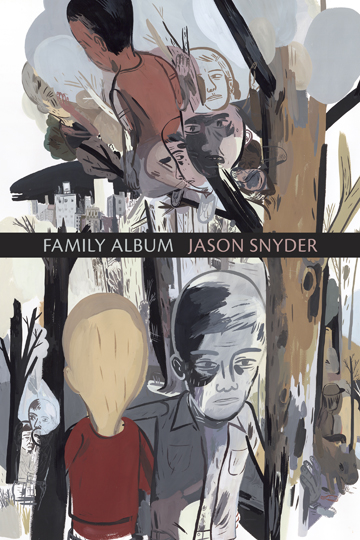“There is no good, there is no evil, there is only flesh. And the patterns to which we submit it.”
–Hellraiser III: Hell on Earth
A colleague I greatly respect wrote and said Family Album (Jaded Ibis Press), the debut novel by Jason Snyder, might be up my alley. I had heard of the book, yes, and was enthused. But the first thing that came into my mind was, “I have an alley!” Thus, my ingress into Family Album was built, unfairly, on a strange perception that it would be the book that coincided perfectly with the luminous embroidered text in my mind’s eye, which nothing, not even what I’ve written myself has succeeded in matching. Perhaps it would be of value to approach the reading of every text in this way, anticipating that it will be the perfect fit for you. Is this a preemptory condemnation, setting it up to fail? Or, is it a way of challenging yourself to take something valuable from the book, to make it closer to your ideal than it might have been had you simply meh’d your way past the front cover? Family Album needed that optimism. It is an agonizing and relentless book.
The torment of Family Album follows a strict pattern. This is the way the reader can organize their hopes, like scratching daily marks on the wall of a prison cell. One knows exactly where one is, in whose head, in whose value system, at any given time, by virtue of the pattern language. This rigor is how we get to know the inhabitants of the book, by their location in a pattern, and yet its function does not end there. It is not content with navel gazing about its own contrivance. It capitalizes on the knowledge and stability bestowed by the pattern to provide a foundation for these people to make mistakes within it. The people in this book—I choose not to call them characters—utilize the pattern, like a lattice of razor blade incisions, to burrow into your flesh where they can nest and do more damage.
Experiencing this pain I persistently dwelled on why this text was my perfect text. Who are these people? What are people doing here? I had the good fortune, immediately after Family Album, to read Gregory Howard’s Hospice, and was lent the line, “What is anything doing anywhere?” a line I took to heart and rationalized, to myself, as a lack of interest in people. However, I think Howard meant it as a real question that was meant to be delved into, as a way to give things their places, rather than my belief that it was meant as a dismissive throwing up of the arms, and to much the opposite point, “Why does anything need to be anywhere?”
Thus, from my vantage I spent most of my time hopefully fighting the book and its people, fighting my interest in them—out of a concern that I was being given too much information, that I didn’t deserve this insight. It feels unseemly to know what people make out of anger, desperation, and self-loathing in the secrecy of their minds, particularly Matthew, the youth onto whom the text piles. It feels voyeuristic in a way I am not comfortable with. It feels inappropriate to my patrician reservedness. Although it was made very clear on the title page that it was not the case, I had the omnipresent sense that the book could not have possibly been written by someone who had not experienced these events directly himself. Understanding, to a certain point, the process of writing a book and how the aspects of verisimilitude can be generated by friction over time, rather than by transcription, it is certainly possible that the book is purely fiction. Zane Grey wrote 89 novels. Danielle Steel has written 98 novels (one of which, called Family Album, is about a female movie director who gets her start on the Zane Grey Theater television series). Nobody has lived that many tales. Nobody has even heard that many tales! One must be inventive. But a work like Family Album, a first novel, reads far more like a transcription of voices from a specific past, and from a specific perspective. Desperately not wanting to, and not intellectually needing to bait Snyder on this point, I will say that this discomfort, this patina is Family Album‘s intrinsic strength, more than the distraction I am making it out to be. The patina of truth is not what luridly interested me about the book, but what strategically interested me about how I was reading it.
There were three aspects of the book, on the printed surface of the page, odd meters, formatting, and content innovations, that were undoubtedly up my alley. However, these rhetorical tactics that I long to enjoy at a distance for their craft like a decorative sterling punchbowl vitrined in a museum, in Family Album were made to be used to get a party hammered. It is not possible to appreciate them without enduring the suffering they manifest. Through these three mechanisms, in the way I prefer to read, Family Album is less about a family, but that the book itself is the family.
First, Snyder’s prose is bizarre. Much of the text is riddled with what I would describe as a tic.
“And how your stomach to know you had pushed the knife through the cardboard without feeling anything… And to heal every split between them had split the box open inside you are not the one you remember doing these things. And to surface into yourself.”
The tic tactic induces a level of discomfort for the reader, an inability to stay in flow. It is a voice wrought by deferral and avoidance, as if wanting to say something, but not having the confidence. In as much as the texture of the prose is constructing an image and an identity for Matthew, it also is telling us that there is something not being shared with us, that would be too much to bear—like Scorcese’s camera in Taxi Driver looking down the hallway when Travis gets dumped over the phone by Betsy. And in a book as monolithically bleak and internally sadistic as Family Album, this is both a blessing and a truly upsetting prospect. The cut-up inherent in this tic is odd, but not absurd. It is intra rather than inter. Rather than choking, it is hedging. Rather than indicating that the text itself is unstable, as a construct, it is the voices of people—because these are clearly people—who are unstable through the text. This has a noisy quality, like a transmission interrupted by static.
Second, among its many idiosyncratic formatting approaches, the use of stereophonic conversations, printed in parallel columns on a page, is most productive. Much like Michel Butor’s use of multiple text “tracks” or “channels” in Niagara, the effect is cacophonous. One must choose sides. One must assign priority. Although not always the voices of Matthew’s mother and father in these channels, the reader is empathetic to the splitting that occurs in this family dynamic. This is a different sort of noisiness, one that rips rather than grates. My election to read across the columns, rather than down then up then down again, produced some noticeable concurrences. On the left channel:
“He’s come a long way, sweetie. Believe me. He has a hard time showing it, but he’s pulling for you, pulling for us as a family.”
On the right channel:
“Thanks to your coddling, your son is developing into quite a sociopath. Is that what you want of my legacy? A son who can’t fathom let alone acknowledge the respect I have earned and deserve?”
The channels are balanced with negative energy. The reader develops a physical inkling of emotional pain inflicted on the head placed between these two forces.
Third, the inclusion of class assignments written by Matthew are the primary vehicle for introducing metaphor into the text. These writings cover a variety of topics from reproduction in frogs to the architecture of castles. Each is a veiled metaphor for something that Matthew is enduring at home, in school, or inside his mind. Other than these short clippings from Matthew’s school file, the text of Family Album contrasts as being blunt, immediate, and concrete. To persistently remove the promise inherent in metaphor, that the text is really driving at something else potentially less intimately damaging, only to corral it in a contextual location from which the metaphor points back at the even more horrible reality of the true text, is crippling, and is the most potent tessera in the pattern of Family Album.
Though approaching Family Album as though it was going to be the most bespoke text to my tastes, the effect over time grew from “Who are these people inhabiting my beloved book?” to “Who am I?” From “How is this happening to these people?” to “Why me? I’m a decent person, aren’t I? I know these things are possible. I know how fragile the social contract can be, especially within a family. I know I could never allow myself to slip across the vague precipice into such cruel manipulation and exploitation of power dynamics. Why me? How was this especially applicable to me? Why did she think this was up my alley? What was she trying to tell me? What is Snyder trying to do to me? What gives me the right to this intimacy? Why would I be interested in people? These people aren’t real. These people couldn’t possibly be real. I hope nothing worse happens. Can I have a moment of respite?”
This is a book, that if given the space, affects the reader specifically, surgically, methodically, deeply, and lastingly.
John Trefry is the author of PLATS and THY DECAY THOU SEEST BY THY DESIRE, proprietor of Inside the Castle press, contributor to entropymag.org, architect with the work.group @ sisyphean.com. He lives in Lawrence, Kansas. @trefryesque


